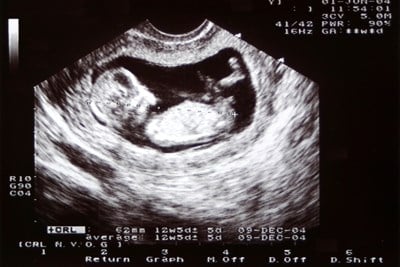Amniocentesis is a diagnostic test performed between 16 and 20 weeks into the pregnancy. A tiny amount of the amniotic fluid that surrounds the baby in the womb is taken and analyzed. The fluid contains cells from the baby, and these can be used to determine if a chromosomal or genetic defect is present. It is not a routine test; rather it is given when there is a risk for a genetic disorder or chromosomal abnormality that cause birth defects.
Of all birth defects reported in the United States, almost 70% have no known cause according to the American Congress of Obstetricians and Gynecologists. Although the test is primarily used to determine genetic disorders, it can also be used later in the pregnancy to ascertain if the baby's lungs are developed, to discover uterine infections, or to determine Rh sensitization problems. Birth defects are rare in the United States, affecting only two or three percent of children so this test is frequently used to rule out the presence of chromosomal damage. Because this is an invasive testing, there is a slight risk for side effects. An alternative test, the chorionic villus sampling (CVS) test, can be performed earlier in pregnancy but carries a higher risk of adverse side effects.
Who Should Consider Amniocentesis
Due to the risk of side effects, this test is not a routine test offered to all. It is reserved for those at higher risk for genetic or chromosomal problems. According to the March of Dimes, the most common use of amniocentesis is in women who will give birth at age 35 or older. These mothers have a greater risk of the most common chromosomal disorder, Down syndrome. Other women at risk may have a prior child with a genetic birth defect or a family history of certain genetic disorders.
Genetic Disorders that Amniocentesis Detects
Down syndrome is the most common of the chromosomal disorders. The risk increases with maternal age from an incidence of 1 in 1,250 for mothers in their 20s to 1 in 400 when the mothers are age 35. By age 40, the risk increases to 1 in 100 births according to the American College of Obstetricians and Gynecologists. This disorder is the result of faulty chromosomal numbers in the egg or sperm. The result is an extra chromosome number 21, and is called trisomy 21.
Other less common genetic disorders that amniocentesis can detect include cystic fibrosis, Tay-Sachs, muscular dystrophy, and sickle cell disease. Additional testing is done on the fluid to determine the alpha-fetoprotein levels in the fluid that may indicate a neural tube defect such as spina bifida or anencephaly.
Testing Procedures
In order to obtain a sample of the amniotic fluid, the doctor inserts a thin needle through the wall of the abdomen and uterus and withdraws a small portion of the amniotic fluid. Simultaneously, an ultrasound is used to determine the position of the baby in the uterus. This fluid surrounds and cushions the fetus in the womb. It contains sloughed off cells from the baby used for genetic testing. Once the fluid is obtained, the sample is sent to a lab.
Once the lab receives the sample, a special culture is grown from the cells of the baby. This process can take a little less than two weeks. The cells are then put under a microscope to study the chromosomes for abnormalities. According to the American Congress of Obstetricians and Gynecologists, amniocentesis rarely involves side effects. Although uncommon, the process could result in cramping, infection, or leaking of the amniotic fluid. There is less than a one percent chance of miscarriage.
Decisions After Receiving the Results
Results of amniocentesis are over 99% accurate for chromosomal disorders and will be received at your doctor's office within three weeks. In the vast majority of cases, the tests indicate that there are no problems. If a problem is detected, discuss the options with your doctor.




